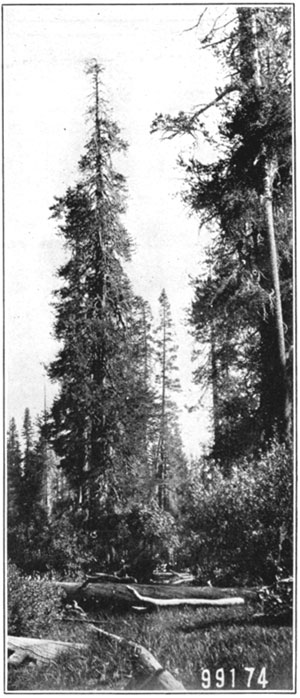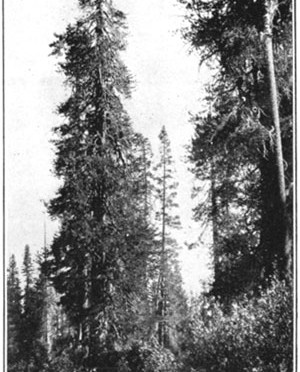Forests of Crater Lake National Park
Lodgepole Pine (Pinus Contorta)
There is one tree in particular whose occurrence in the park is nearly general, except upon the highest peaks. This is the lodgepole pine (Pinus contorta) that, in various regions, is known under the name of black pine, scrub pine, tamarack, and jack pine. This wanderer is equally at home from the glaciers of Alaska to southern California and from the sand dunes of the Pacific to the Rocky Mountains.
In central and southern Oregon vast stands of pure lodgepole pine occur, covering high sandy plateaus and steep mountain slopes alike with a thick forest of small poles. In other places it creeps in among its larger brethren, the sugar pine, yellow pine, and fir, and is content in forming an under story beneath their taller crowns.
Lodgepole (fig. 9) is the only Pacific coast pine that invariably bears its needles in clusters of two. The harsh, slightly curved needles are about 2 inches long, bright yellow green, and thickly clothe the outer portion of the slender twigs. The small prickly cones are wonderfully persistent, and often cling to the branches for many years without liberating their tiny seeds. Sixty feet is an average height for this tree, and it rarely exceeds a diameter of 20 inches. In dense forests the slender trunks, clothed with reddish-brown checked bark, carry open, rounded, or slender cylindrical crowns.

Fig. 9—Lodgepole pine (Pinus contorta) 60 inches in diameter.
Dense stands of lodgepole pine are sadly ravaged by bark beetles and fire, against which their thin bark offers little protection. The timber over thousands of acres has been killed by these causes, but owing to the great vitality of the seed and the fact that much of it is liberated after the trees are dead, the stand is soon replaced by a dense growth of seedlings. It also has replaced other species over immense areas denuded by early fires.
Lodgepole pine does not yet claim much attention in the lumber industry, as only about 1 per cent of the total lumber cut is made up of this timber. The long clean trunks produced in dense stands are growing in favor for posts, poles, and ties, and the species is particularly valuable for watershed protection in many dry regions unfavorable for other trees.
From Fort Klamath to Crater Lake lodgepole pine will be seen in abundance, at some places in dense pole thickets, but more often mixed among other species. Lodgepole pine is one of the trees in the forest background that sets off to such advantage the carved walls and pillars of the wonderful Anna Creek Canyon. Within the park and below the western entrance persistent growths of this tree climb from the lower moraine-littered slopes up to the very rim of the crater. Wherever it occurs it is much the same cheerful, hardy tree, adapting itself to dry pumice sands and wet marsh borders alike, and doing more than its share in forming the forest cover over vast areas in the higher mountain regions.
Other pages in this section
*** previous title *** --- *** next title ***


